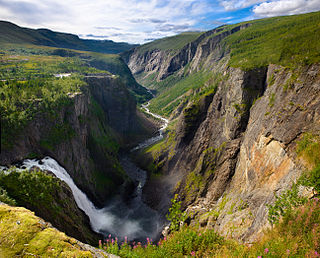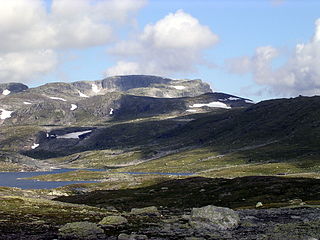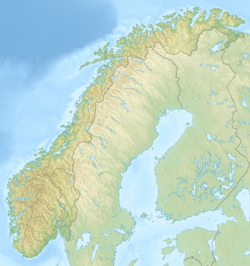
Buskerud is a county and a current electoral district in Norway, bordering Akershus, Oslo, Oppland, Sogn og Fjordane, Hordaland, Telemark and Vestfold. The region extends from the Oslofjord and Drammensfjorden in the southeast to Hardangervidda mountain range in the northwest. The county administration was in modern times located in Drammen. Buskerud was merged with Akershus and Østfold into the newly created Viken County on 1 January 2020. On the 23 February 2022 Viken County Council voted in a 49 against 38 decision to submit an application to the Norwegian government for a county demerger. Due to this, Buskerud was re-established in 2024.

Nore og Uvdal is a municipality in Buskerud county, Norway. It is part of the traditional region of Numedal. The administrative centre of the municipality is the village of Rødberg.

Ullensvang is a municipality in Vestland county, Norway. It is located in the traditional district of Hardanger. The administrative centre is the town of Odda. Some of the notable villages in the municipality include Lofthus, Utne, Vikebygd, Alsåker, Botnen, Eitrheim, Håra, Røldal, Seljestad, Skare, Tyssedal, Jondal, Herand, Kysnesstranda, and Torsnes.

Eidfjord is a municipality in Vestland county, Norway. The municipality is located in the traditional district of Hardanger. The administrative centre of the municipality is the village of Eidfjord, where the majority of the municipal population lives. The other major population centre in the municipality is the village of Øvre Eidfjord.

Rondane National Park is the oldest national park in Norway, established on 21 December 1962. The park is located in Innlandet county, in the municipalities of Dovre, Folldal, Sel, Nord-Fron, Sør-Fron, Stor-Elvdal, and Ringebu. The park contains ten peaks above 2,000 metres (6,560 ft), with the highest being Rondeslottet at an altitude of 2,178 m (7,146 ft). The park is an important habitat for herds of wild reindeer.

Numedal is a valley and a traditional district in Eastern Norway located within the county of Buskerud. It traditionally includes the municipalities Flesberg, Nore og Uvdal and Rollag. Administratively, it now also includes Kongsberg.

The Hardangerfjord is the fifth longest fjord in the world, and the second longest fjord in Norway. It is located in Vestland county in the Hardanger region. The fjord stretches 179 kilometres (111 mi) from the Atlantic Ocean into the mountainous interior of Norway along the Hardangervidda plateau. The innermost point of the fjord reaches the town of Odda.

Hardanger is a traditional district in the western part of Norway, dominated by the Hardangerfjord and its inner branches of the Sørfjorden and the Eid Fjord. It consists of the municipalities of Ullensvang, Eidfjord, Ulvik and Kvam, and is located inside the county of Vestland.

Jotunheimen National Park is a national park in Norway, recognized as one of the country's premier hiking and fishing regions. The national park covers 1,151 square kilometres (444 sq mi) and is part of the larger area Jotunheimen. More than 250 peaks rise above an elevation of 1,900 metres (6,200 ft), including Northern Europe's two highest peaks: Galdhøpiggen at 2,469 metres (8,100 ft), and Glittertind at 2,465 metres (8,087 ft).

Hardangervidda National Park, at 3,422 square kilometres (1,321 sq mi), is Norway's largest national park. It spans from Numedal and Uvdal in the east and Røvelseggi and Ullensvang in the west across the Hardanger mountain plateau (Hardangervidda). Designated as a national park in 1981, today it serves as a popular tourist destination for activities such as hiking, climbing, fishing, and cross-country skiing. The Norwegian Mountain Touring Association (DNT) maintains a comprehensive network of huts and paths across Hardangervidda. The Bergen Line and the main Highway 7 cross the plateau. The park lies in Viken, Vestland, and Vestfold og Telemark counties.
Tinnhølen or Tinnhylen is a lake in Norway that lies in the municipality of Eidfjord in Vestland county and a very small part crosses into the municipality of Nore og Uvdal in Viken county. The lake lies just inside Hardangervidda National Park on the vast Hardangervidda plateau. The northern part of the lake is accessible by road.

Kvennsjøen is a lake in the municipality of Ullensvang in Vestland county, Norway. The 5.05-square-kilometre (1.95 sq mi) lake lies on the Hardangervidda plateau, inside the Hardangervidda National Park. The alpine lake is located 35 kilometres (22 mi) straight east of the town of Odda and about 45 kilometres (28 mi) south of the village of Eidfjord. There are over 500 lakes in Ullensvang municipality and this one is the largest of all of them.
Halnefjorden is a large lake on the border of Vestland and Viken counties in Norway. It is located in the municipalities of Hol and Nore og Uvdal in Viken county and in Eidfjord municipality in Vestland county. At 13.61 square kilometres (5.25 sq mi), it is among the largest lakes located on the vast Hardangervidda plateau. The Norwegian National Road 7 runs along the northern shore of the lake, and that is the only road access to the lake. The lake is one of the headwaters of the river Numedalslågen.
Skaupsjøen is a lake in the municipalities of Eidfjord in Vestland county and Nore og Uvdal in Viken county, Norway. The 2.88-square-kilometre (1.11 sq mi) lake lies just north of the Hardangervidda National Park on the vast Hardangervidda plateau. The lake outflows to the river Skaupa, which flows into the larger lake Halnefjorden to the northeast. The nearest road access is the Norwegian National Road 7, which passes about 5 kilometres (3.1 mi) northwest of the lake.

Kinsarvik is a village in the municipality of Ullensvang in Vestland county, Norway. The village is located at the end of a small bay at the confluence of the Sørfjorden and the Eid Fjord, where they join to form the main branch of the Hardangerfjorden. The village lies along the Norwegian National Road 13 and it has a ferry port with regular routes that connect it to Utne and Kvanndal across the fjord.

The Scandinavian montane birch forests and grasslands is defined by the World Wildlife Fund (WWF) as a terrestrial tundra ecoregion in Norway, Sweden, and Finland.

Sandfloegga or Sandfloeggi is a mountain in Ullensvang Municipality in southeastern Vestland county, Norway. It lies on the southern part of the vast Hardangervidda mountain plateau, and is the highest mountain on Hardangervidda when the bordering summits of Hardangerjøkulen and Folarskardnuten are omitted. The 1,721-metre (5,646 ft) tall mountain lies inside Hardangervidda National Park, about 10 kilometres (6.2 mi) north of the European route E134 highway.

Eidfjord is the administrative centre of Eidfjord municipality in Vestland county, Norway. The village is located on the shore of the Eid Fjord, an inner branch of the large Hardangerfjorden. The village sits about 15 kilometres (9.3 mi) east of the Hardanger Bridge along the Norwegian National Road 7.

Norwegian National Road 7 is a national road in Norway which runs from the town of Hønefoss in Viken county to the village of Granvin in Vestland county. The route is 387.6 kilometres (240.8 mi) long and runs east–west through Viken and Vestland counties over the vast Hardangervidda plateau.

The Eid Fjord is the innermost part of the Hardanger Fjord in Norway. It extends 29 kilometers (18 mi) eastwards from the Utne Fjord and Sørfjorden. The Eid Fjord lies in the municipalities of Ullensvang, Ulvik, and Eidfjord in Vestland county.





















